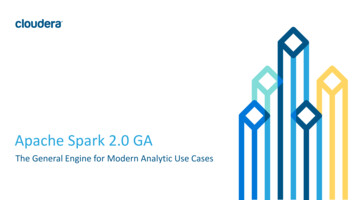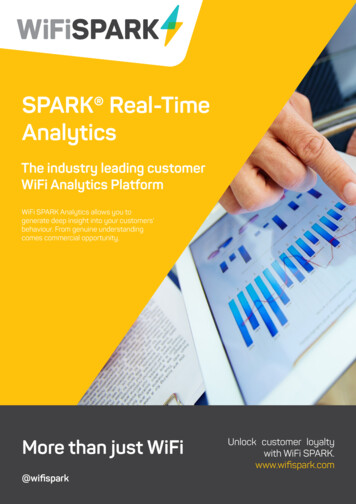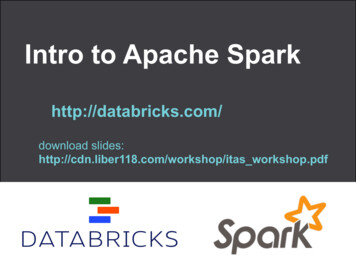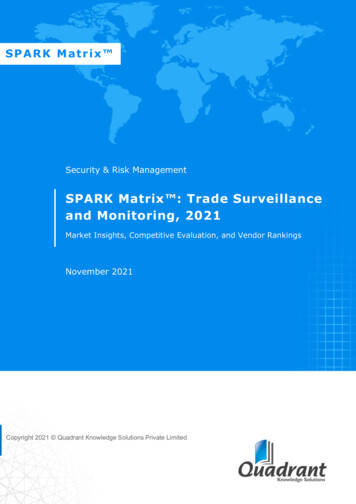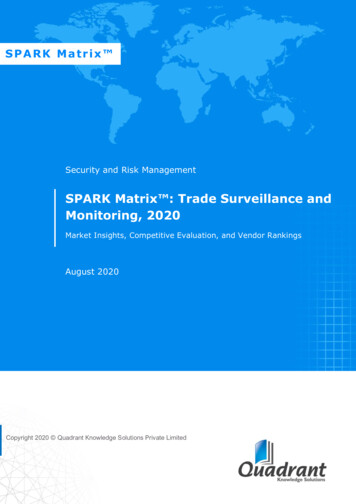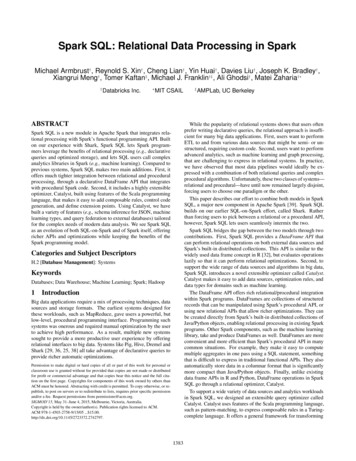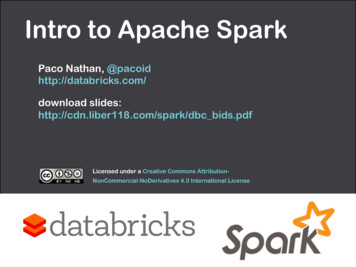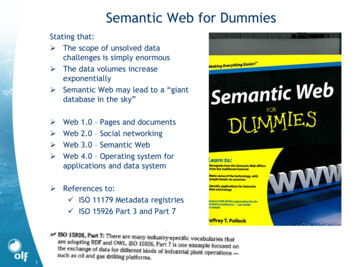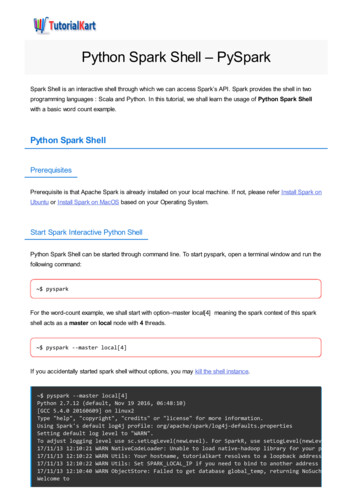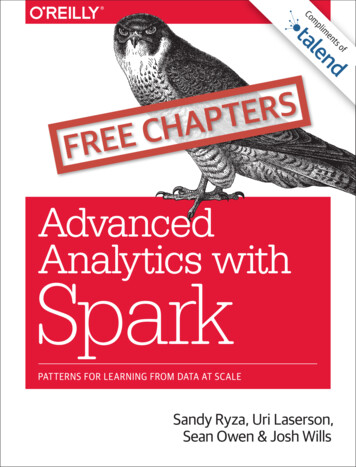
Transcription
ComplimentsofCEEFRSRETPAHAdvancedAnalytics withSparkEERFRETPAHCPATTERNS FOR LEARNING FROM DATA AT SCALESandy Ryza, Uri Laserson,Sean Owen & Josh Wills
The Highest PerformingHadoop Code3 to 5X performance gain usingSpark over MapReduce.Protect your investments with a future-proofarchitecture. The first integration platform toimplement MapReduce, YARN, Spark and Storm.FREE Big Data box
This Excerpt contains Chapters 1 and 2 of the book Advanced Analytics withSpark. The complete book is available at oreilly.com and through other retailers.
Advanced Analytics with SparkSandy Ryza, Uri Laserson, Sean Owen, and Josh WillsBoston
Advanced Analytics with Sparkby Sandy Ryza, Uri Laserson, Sean Owen, and Josh WillsCopyright 2015 Sandy Ryza, Uri Laserson, Sean Owen, and Josh Wills. All rights reserved.Printed in the United States of America.Published by O’Reilly Media, Inc., 1005 Gravenstein Highway North, Sebastopol, CA 95472.O’Reilly books may be purchased for educational, business, or sales promotional use. Online editions arealso available for most titles (http://safaribooksonline.com). For more information, contact our corporate/institutional sales department: 800-998-9938 or corporate@oreilly.com.Editor: Marie BeaugureauProduction Editor: Kara EbrahimCopyeditor: Kim CoferProofreader: Rachel MonaghanIndexer: Judy McConvilleInterior Designer: David FutatoCover Designer: Ellie VolckhausenIllustrator: Rebecca DemarestFirst EditionApril 2015:Revision History for the First Edition2015-03-27:First ReleaseSee http://oreilly.com/catalog/errata.csp?isbn 9781491912768 for release details.The O’Reilly logo is a registered trademark of O’Reilly Media, Inc. Advanced Analytics with Spark, thecover image of a peregrine falcon, and related trade dress are trademarks of O’Reilly Media, Inc.While the publisher and the authors have used good faith efforts to ensure that the information andinstructions contained in this work are accurate, the publisher and the authors disclaim all responsibilityfor errors or omissions, including without limitation responsibility for damages resulting from the use ofor reliance on this work. Use of the information and instructions contained in this work is at your ownrisk. If any code samples or other technology this work contains or describes is subject to open sourcelicenses or the intellectual property rights of others, it is your responsibility to ensure that your usethereof complies with such licenses and/or rights.978-1-491-91276-8[LSI]
Table of ContentsForeword. . . . . . . . . . . . . . . . . . . . . . . . . . . . . . . . . . . . . . . . . . . . . . . . . . . . . . . . . . . . . . . . . . . . . . vPreface. . . . . . . . . . . . . . . . . . . . . . . . . . . . . . . . . . . . . . . . . . . . . . . . . . . . . . . . . . . . . . . . . . . . . . . vii1. Analyzing Big Data. . . . . . . . . . . . . . . . . . . . . . . . . . . . . . . . . . . . . . . . . . . . . . . . . . . . . . . . . . 1The Challenges of Data ScienceIntroducing Apache SparkAbout This Book3472. Introduction to Data Analysis with Scala and Spark. . . . . . . . . . . . . . . . . . . . . . . . . . . . . . . 9Scala for Data ScientistsThe Spark Programming ModelRecord LinkageGetting Started: The Spark Shell and SparkContextBringing Data from the Cluster to the ClientShipping Code from the Client to the ClusterStructuring Data with Tuples and Case ClassesAggregationsCreating HistogramsSummary Statistics for Continuous VariablesCreating Reusable Code for Computing Summary StatisticsSimple Variable Selection and ScoringWhere to Go from Here10111213182223282930313637iii
PrefaceSandy RyzaI don’t like to think I have many regrets, but it’s hard to believe anything good cameout of a particular lazy moment in 2011 when I was looking into how to best distrib‐ute tough discrete optimization problems over clusters of computers. My advisorexplained this newfangled Spark thing he had heard of, and I basically wrote off theconcept as too good to be true and promptly got back to writing my undergrad thesisin MapReduce. Since then, Spark and I have both matured a bit, but one of us hasseen a meteoric rise that’s nearly impossible to avoid making “ignite” puns about. Cutto two years later, and it has become crystal clear that Spark is something worth pay‐ing attention to.Spark’s long lineage of predecessors, running from MPI to MapReduce, makes it pos‐sible to write programs that take advantage of massive resources while abstractingaway the nitty-gritty details of distributed systems. As much as data processing needshave motivated the development of these frameworks, in a way the field of big datahas become so related to these frameworks that its scope is defined by what theseframeworks can handle. Spark’s promise is to take this a little further—to make writ‐ing distributed programs feel like writing regular programs.Spark will be great at giving ETL pipelines huge boosts in performance and easingsome of the pain that feeds the MapReduce programmer’s daily chant of despair(“why? whyyyyy?”) to the Hadoop gods. But the exciting thing for me about it hasalways been what it opens up for complex analytics. With a paradigm that supportsiterative algorithms and interactive exploration, Spark is finally an open sourceframework that allows a data scientist to be productive with large data sets.I think the best way to teach data science is by example. To that end, my colleaguesand I have put together a book of applications, trying to touch on the interactionsbetween the most common algorithms, data sets, and design patterns in large-scaleanalytics. This book isn’t meant to be read cover to cover. Page to a chapter that lookslike something you’re trying to accomplish, or that simply ignites your interest.vii
What’s in This BookThe first chapter will place Spark within the wider context of data science and bigdata analytics. After that, each chapter will comprise a self-contained analysis usingSpark. The second chapter will introduce the basics of data processing in Spark andScala through a use case in data cleansing. The next few chapters will delve into themeat and potatoes of machine learning with Spark, applying some of the most com‐mon algorithms in canonical applications. The remaining chapters are a bit more of agrab bag and apply Spark in slightly more exotic applications—for example, queryingWikipedia through latent semantic relationships in the text or analyzing genomicsdata.Using Code ExamplesSupplemental material (code examples, exercises, etc.) is available for download athttps://github.com/sryza/aas.This book is here to help you get your job done. In general, if example code is offeredwith this book, you may use it in your programs and documentation. You do notneed to contact us for permission unless you’re reproducing a significant portion ofthe code. For example, writing a program that uses several chunks of code from thisbook does not require permission. Selling or distributing a CD-ROM of examplesfrom O’Reilly books does require permission. Answering a question by citing thisbook and quoting example code does not require permission. Incorporating a signifi‐cant amount of example code from this book into your product’s documentation doesrequire permission.We appreciate, but do not require, attribution. An attribution usually includes thetitle, author, publisher, and ISBN. For example: "Advanced Analytics with Spark bySandy Ryza, Uri Laserson, Sean Owen, and Josh Wills (O’Reilly). Copyright 2015Sandy Ryza, Uri Laserson, Sean Owen, and Josh Wills, 978-1-491-91276-8.”If you feel your use of code examples falls outside fair use or the permission givenabove, feel free to contact us at permissions@oreilly.com.Safari Books OnlineSafari Books Online is an on-demand digital library that deliv‐ers expert content in both book and video form from theworld’s leading authors in technology and business.viii Preface
Technology professionals, software developers, web designers, and business and crea‐tive professionals use Safari Books Online as their primary resource for research,problem solving, learning, and certification training.Safari Books Online offers a range of plans and pricing for enterprise, government,education, and individuals.Members have access to thousands of books, training videos, and prepublicationmanuscripts in one fully searchable database from publishers like O’Reilly Media,Prentice Hall Professional, Addison-Wesley Professional, Microsoft Press, Sams, Que,Peachpit Press, Focal Press, Cisco Press, John Wiley & Sons, Syngress, Morgan Kauf‐mann, IBM Redbooks, Packt, Adobe Press, FT Press, Apress, Manning, New Riders,McGraw-Hill, Jones & Bartlett, Course Technology, and hundreds more. For moreinformation about Safari Books Online, please visit us online.How to Contact UsPlease address comments and questions concerning this book to the publisher:O’Reilly Media, Inc.1005 Gravenstein Highway NorthSebastopol, CA 95472800-998-9938 (in the United States or Canada)707-829-0515 (international or local)707-829-0104 (fax)We have a web page for this book, where we list errata, examples, and any additionalinformation. You can access this page at http://bit.ly/advanced-spark.To comment or ask technical questions about this book, send email to bookques‐tions@oreilly.com.For more information about our books, courses, conferences, and news, see our web‐site at http://www.oreilly.com.Find us on Facebook: http://facebook.com/oreillyFollow us on Twitter: http://twitter.com/oreillymediaWatch us on YouTube: It goes without saying that you wouldn’t be reading this book if it were not for theexistence of Apache Spark and MLlib. We all owe thanks to the team that has builtand open sourced it, and the hundreds of contributors who have added to it.Preface ix
We would like to thank everyone who spent a great deal of time reviewing the contentof the book with expert eyes: Michael Bernico, Ian Buss, Jeremy Freeman, ChrisFregly, Debashish Ghosh, Juliet Hougland, Jonathan Keebler, Frank Nothaft, NickPentreath, Kostas Sakellis, Marcelo Vanzin, and Juliet Hougland again. Thanks all! Weowe you one. This has greatly improved the structure and quality of the result.I (Sandy) also would like to thank Jordan Pinkus and Richard Wang for helping mewith some of the theory behind the risk chapter.Thanks to Marie Beaugureau and O’Reilly, for the experience and great support ingetting this book published and into your hands.x Preface
CHAPTER 1Analyzing Big DataSandy Ryza[Data applications] are like sausages. It is better not to see them being made.—Otto von Bismarck Build a model to detect credit card fraud using thousands of features and billionsof transactions. Intelligently recommend millions of products to millions of users. Estimate financial risk through simulations of portfolios including millions ofinstruments. Easily manipulate data from thousands of human genomes to detect genetic asso‐ciations with disease.These are tasks that simply could not be accomplished 5 or 10 years ago. When peo‐ple say that we live in an age of “big data,” they mean that we have tools for collecting,storing, and processing information at a scale previously unheard of. Sitting behindthese capabilities is an ecosystem of open source software that can leverage clusters ofcommodity computers to chug through massive amounts of data. Distributed systemslike Apache Hadoop have found their way into the mainstream and have seen wide‐spread deployment at organizations in nearly every field.But just as a chisel and a block of stone do not make a statue, there is a gap betweenhaving access to these tools and all this data, and doing something useful with it. Thisis where “data science” comes in. As sculpture is the practice of turning tools and rawmaterial into something relevant to nonsculptors, data science is the practice of turn‐ing tools and raw data into something that nondata scientists might care about.1
Often, “doing something useful” means placing a schema over it and using SQL toanswer questions like “of the gazillion users who made it to the third page in ourregistration process, how many are over 25?” The field of how to structure a datawarehouse and organize information to make answering these kinds of questionseasy is a rich one, but we will mostly avoid its intricacies in this book.Sometimes, “doing something useful” takes a little extra. SQL still may be core to theapproach, but to work around idiosyncrasies in the data or perform complex analysis,we need a programming paradigm that’s a little bit more flexible and a little closer tothe ground, and with richer functionality in areas like machine learning and statistics.These are the kinds of analyses we are going to talk about in this book.For a long time, open source frameworks like R, the PyData stack, and Octave havemade rapid analysis and model building viable over small data sets. With fewer than10 lines of code, we can throw together a machine learning model on half a data setand use it to predict labels on the other half. With a little more effort, we can imputemissing data, experiment with a few models to find the best one, or use the results ofa model as inputs to fit another. What should an equivalent process look like that canleverage clusters of computers to achieve the same outcomes on huge data sets?The right approach might be to simply extend these frameworks to run on multiplemachines, to retain their programming models and rewrite their guts to play well indistributed settings. However, the challenges of distributed computing require us torethink many of the basic assumptions that we rely on in single-node systems. Forexample, because data must be partitioned across many nodes on a cluster, algorithmsthat have wide data dependencies will suffer from the fact that network transfer ratesare orders of magnitude slower than memory accesses. As the number of machinesworking on a problem increases, the probability of a failure increases. These factsrequire a programming paradigm that is sensitive to the characteristics of the under‐lying system: one that discourages poor choices and makes it easy to write code thatwill execute in a highly parallel manner.Of course, single-machine tools like PyData and R that have come to recent promi‐nence in the software community are not the only tools used for data analysis. Scien‐tific fields like genomics that deal with large data sets have been leveraging parallelcomputing frameworks for decades. Most people processing data in these fields todayare familiar with a cluster-computing environment called HPC (high-performancecomputing). Where the difficulties with PyData and R lie in their inability to scale,the difficulties with HPC lie in its relatively low level of abstraction and difficulty ofuse. For example, to process a large file full of DNA sequencing reads in parallel, wemust manually split it up into smaller files and submit a job for each of those files tothe cluster scheduler. If some of these fail, the user must detect the failure and takecare of manually resubmitting them. If the analysis requires all-to-all operations likesorting the entire data set, the large data set must be streamed through a single node,2 Chapter 1: Analyzing Big Data
or the scientist must resort to lower-level distributed frameworks like MPI, which aredifficult to program without extensive knowledge of C and distributed/networkedsystems. Tools written for HPC environments often fail to decouple the in-memorydata models from the lower-level storage models. For example, many tools only knowhow to read data from a POSIX filesystem in a single stream, making it difficult tomake tools naturally parallelize, or to use other storage backends, like databases.Recent systems in the Hadoop ecosystem provide abstractions that allow users totreat a cluster of computers more like a single computer—to automatically split upfiles and distribute storage over many machines, to automatically divide work intosmaller tasks and execute them in a distributed manner, and to automatically recoverfrom failures. The Hadoop ecosystem can automate a lot of the hassle of workingwith large data sets, and is far cheaper than HPC.The Challenges of Data ScienceA few hard truths come up so often in the practice of data science that evangelizingthese truths has become a large role of the data science team at Cloudera. For a sys‐tem that seeks to enable complex analytics on huge data to be successful, it needs tobe informed by, or at least not conflict with, these truths.First, the vast majority of work that goes into conducting successful analyses lies inpreprocessing data. Data is messy, and cleansing, munging, fusing, mushing, andmany other verbs are prerequisites to doing anything useful with it. Large data sets inparticular, because they are not amenable to direct examination by humans, canrequire computational methods to even discover what preprocessing steps arerequired. Even when it comes time to optimize model performance, a typical datapipeline requires spending far more time in feature engineering and selection than inchoosing and writing algorithms.For example, when building a model that attempts to detect fraudulent purchases ona website, the data scientist must choose from a wide variety of potential features: anyfields that users are required to fill out, IP location info, login times, and click logs asusers navigate the site. Each of these comes with its own challenges in converting tovectors fit for machine learning algorithms. A system needs to support more flexibletransformations than turning a 2D array of doubles into a mathematical model.Second, iteration is a fundamental part of the data science. Modeling and analysis typ‐ically require multiple passes over the same data. One aspect of this lies withinmachine learning algorithms and statistical procedures. Popular optimization proce‐dures like stochastic gradient descent and expectation maximization involve repeatedscans over their inputs to reach convergence. Iteration also matters within the datascientist’s own workflow. When data scientists are initially investigating and trying toget a feel for a data set, usually the results of a query inform the next query thatshould run. When building models, data scientists do not try to get it right in one try.The Challenges of Data Science 3
Choosing the right features, picking the right algorithms, running the right signifi‐cance tests, and finding the right hyperparameters all require experimentation. Aframework that requires reading the same data set from disk each time it is accessedadds delay that can slow down the process of exploration and limit the number ofthings we get to try.Third, the task isn’t over when a well-performing model has been built. If the point ofdata science is making data useful to nondata scientists, then a model stored as a listof regression weights in a text file on the data scientist’s computer has not reallyaccomplished this goal. Uses of data recommendation engines and real-time frauddetection systems culminate in data applications. In these, models become part of aproduction service and may need to be rebuilt periodically or even in real time.For these situations, it is helpful to make a distinction between analytics in the laband analytics in the factory. In the lab, data scientists engage in exploratory analytics.They try to understand the nature of the data they are working with. They visualize itand test wild theories. They experiment with different classes of features and auxiliarysources they can use to augment it. They cast a wide net of algorithms in the hopesthat one or two will work. In the factory, in building a data application, data scientistsengage in operational analytics. They package their models into services that caninform real-world decisions. They track their models’ performance over time andobsess about how they can make small tweaks to squeeze out another percentagepoint of accuracy. They care about SLAs and uptime. Historically, exploratory analyt‐ics typically occurs in languages like R, and when it comes time to build productionapplications, the data pipelines are rewritten entirely in Java or C .Of course, everybody could save time if the original modeling code could be actuallyused in the app for which it is written, but languages like R are slow and lack integra‐tion with most planes of the production infrastructure stack, and languages like Javaand C are just poor tools for exploratory analytics. They lack Read-Evaluate-PrintLoop (REPL) environments for playing with data interactively and require largeamounts of code to express simple transformations. A framework that makes model‐ing easy but is also a good fit for production systems is a huge win.Introducing Apache SparkEnter Apache Spark, an open source framework that combines an engine for distrib‐uting programs across clusters of machines with an elegant model for writing pro‐grams atop it. Spark, which originated at the UC Berkeley AMPLab and has sincebeen contributed to the Apache Software Foundation, is arguably the first opensource software that makes distributed programming truly accessible to datascientists.4 Chapter 1: Analyzing Big Data
One illuminating way to understand Spark is in terms of its advances over its prede‐cessor, MapReduce. MapReduce revolutionized computation over huge data sets byoffering a simple model for writing programs that could execute in parallel acrosshundreds to thousands of machines. The MapReduce engine achieves near linearscalability—as the data size increases, we can throw more computers at it and see jobscomplete in the same amount of time—and is resilient to the fact that failures thatoccur rarely on a single machine occur all the time on clusters of thousands. It breaksup work into small tasks and can gracefully accommodate task failures without com‐promising the job to which they belong.Spark maintains MapReduce’s linear scalability and fault tolerance, but extends it inthree important ways. First, rather than relying on a rigid map-then-reduce format,its engine can execute a more general directed acyclic graph (DAG) of operators. Thismeans that, in situations where MapReduce must write out intermediate results to thedistributed filesystem, Spark can pass them directly to the next step in the pipeline. Inthis way, it is similar to Dryad, a descendant of MapReduce that originated at Micro‐soft Research. Second, it complements this capability with a rich set of transforma‐tions that enable users to express computation more naturally. It has a strongdeveloper focus and streamlined API that can represent complex pipelines in a fewlines of code.Third, Spark extends its predecessors with in-memory processing. Its Resilient Dis‐tributed Dataset (RDD) abstraction enables developers to materialize any point in aprocessing pipeline into memory across the cluster, meaning that future steps thatwant to deal with the same data set need not recompute it or reload it from disk. Thiscapability opens up use cases that distributed processing engines could not previouslyapproach. Spark is well suited for highly iterative algorithms that require multiplepasses over a data set, as well as reactive applications that quickly respond to userqueries by scanning large in-memory data sets.Perhaps most importantly, Spark fits well with the aforementioned hard truths of datascience, acknowledging that the biggest bottleneck in building data applications is notCPU, disk, or network, but analyst productivity. It perhaps cannot be overstated howmuch collapsing the full pipeline, from preprocessing to model evaluation, into a sin‐gle programming environment can speed up development. By packaging an expres‐sive programming model with a set of analytic libraries under a REPL, it avoids theround trips to IDEs required by frameworks like MapReduce and the challenges ofsubsampling and moving data back and forth from HDFS required by frameworkslike R. The more quickly analysts can experiment with their data, the higher likeli‐hood they have of doing something useful with it.With respect to the pertinence of munging and ETL, Spark strives to be somethingcloser to the Python of big data than the Matlab of big data. As a general-purposecomputation engine, its core APIs provide a strong foundation for data transforma‐Introducing Apache Spark 5
tion independent of any functionality in statistics, machine learning, or matrix alge‐bra. Its Scala and Python APIs allow programming in expressive general-purposelanguages, as well as access to existing libraries.Spark’s in-memory caching makes it ideal for iteration both at the micro and macrolevel. Machine learning algorithms that make multiple passes over their training setcan cache it in memory. When exploring and getting a feel for a data set, data scien‐tists can keep it in memory while they run queries, and easily cache transformed ver‐sions of it as well without suffering a trip to disk.Last, Spark spans the gap between systems designed for exploratory analytics and sys‐tems designed for operational analytics. It is often quoted that a data scientist issomeone who is better at engineering than most statisticians and better at statisticsthan most engineers. At the very least, Spark is better at being an operational systemthan most exploratory systems and better for data exploration than the technologiescommonly used in operational systems. It is built for performance and reliabilityfrom the ground up. Sitting atop the JVM, it can take advantage of many of theoperational and debugging tools built for the Java stack.Spark boasts strong integration with the variety of tools in the Hadoop ecosystem. Itcan read and write data in all of the data formats supported by MapReduce, allowingit to interact with the formats commonly used to store data on Hadoop like Avro andParquet (and good old CSV). It can read from and write to NoSQL databases likeHBase and Cassandra. Its stream processing library, Spark Streaming, can ingest datacontinuously from systems like Flume and Kafka. Its SQL library, SparkSQL, caninteract with the Hive Metastore, and a project that is in progress at the time of thiswriting seeks to enable Spark to be used as an underlying execution engine for Hive,as an alternative to MapReduce. It can run inside YARN, Hadoop’s scheduler andresource manager, allowing it to share cluster resources dynamically and to be man‐aged with the same policies as other processing engines like MapReduce and Impala.Of course, Spark isn’t all roses and petunias. While its core engine has progressed inmaturity even during the span of this book being written, it is still young compared toMapReduce and hasn’t yet surpassed it as the workhorse of batch processing. Its spe‐cialized subcomponents for stream processing, SQL, machine learning, and graphprocessing lie at different stages of maturity and are undergoing large API upgrades.For example, MLlib’s pipelines and transformer API model is in progress while thisbook is being written. Its statistics and modeling functionality comes nowhere nearthat of single machine languages like R. Its SQL functionality is rich, but still lags farbehind that of Hive.6 Chapter 1: Analyzing Big Data
About This BookThe rest of this book is not going to be about Spark’s merits and disadvantages. Thereare a few other things that it will not be either. It will introduce the Spark program‐ming model and Scala basics, but it will not attempt to be a Spark reference or pro‐vide a comprehensive guide to all its nooks and crannies. It will not try to be amachine learning, statistics, or linear algebra reference, although many of the chap‐ters will provide some background on these before using them.Instead, it will try to help the reader get a feel for what it’s like to use Spark for com‐plex analytics on large data sets. It will cover the entire pipeline: not just building andevaluating models, but cleansing, preprocessing, and exploring data, with attentionpaid to turning results into production applications. We believe that the best way toteach this is by example, so, after a quick chapter describing Spark and its ecosystem,the rest of the chapters will be self-contained illustrations of what it looks like to useSpark for analyzing data from different domains.When possible, we will attempt not to just provide a “solution,” but to demonstratethe full data science workflow, with all of its iterations, dead ends, and restarts. Thisbook will be useful for getting more comfortable with Scala, more comfortable withSpark, and more comfortable with machine learning and data analysis. However,these are in service of a larger goal, and we hope that most of all, this book will teachyou how to approach tasks like those described at the beginning of this chapter. Eachchapter, in about 20 measly pages, will try to get as close as possible to demonstratinghow to build one of these pieces of data applications.About This Book 7
CHAPTER 2Introduction to Data Analysis withScala and SparkJosh WillsIf you are immune to boredom, there is literally nothing you cannot accomplish.—David Foster WallaceData cleansing is the first step in any data science project, and often the most impor‐tant. Many clever analyses have been undone because the data analyzed had funda‐mental quality problems or underlying artifacts that biased the analysis or led thedata scientist to see things that weren’t really there.Despite its importance, most textbooks and classes on data science either don’t coverdata cleansing or only give it a passing mention. The explanation for this is simple:cleansing data is really boring. It is the tedious, dull work that you have to do beforeyou can get to the really cool machine learning algori
problem solving, learning, and certification training. Safari Books Online offers a range of plans and pricing for enterprise, government, education, and individuals. Members have access to thousands of books, training videos, and prepublication manuscripts in one fully searchable datab
